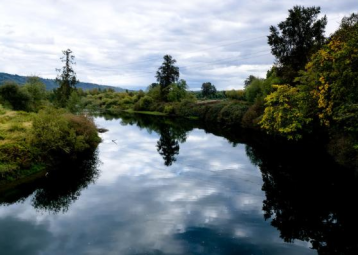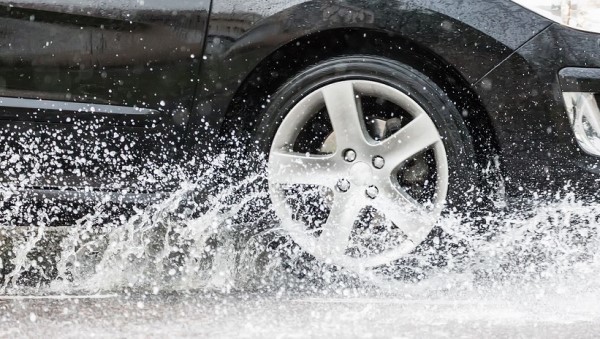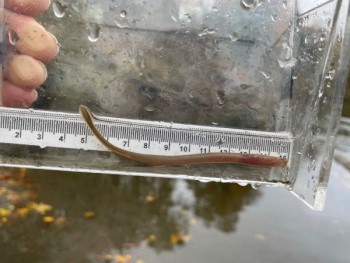What's New in the Snoqualmie Watershed
In this edition...
Washington Department of Natural Resources’ Watershed Resilience Action Plan proposes a watershed-scale strategy for Snohomish salmon
 |
| The mouth of the Snohomish River and Possession Sound. (Olivia Vanni / The Herald) |
Washington Dept. of Natural Resources (DNR) recently released the "Watershed Resilience Action Plan: A Tree to Sea plan for landscape scale restoration and salmon recovery in the Snohomish Watershed. In the document, Commissioner of Public Lands Hilary Franz outlines a system of fixes to bring back salmon and other fish to the river earlier this month. Citing 16 populations of salmon and salmon-related fish that are now endangered or threatened, the plan calls for protection and cleanup of aquatic habitat from the forests of the Cascades to where the river empties into the salt water of the Salish Sea. See DNR’s Press Release with links to the full plan and summary, King5 coverage of the launch event, and The Daily Herald article Save salmon, create jobs: A new plan for Snohomish watershed
 |
| Photo courtesy of Microsoft Bing |
Deadly tire chemical responsible for coho die-offs found to be toxic to other fish species
Puget Sound scientists have known for a long time that something in stormwater is killing our coho. Recently, UW Tacoma scientists discovered that the culprit is 6ppd-quinone, a preservative in tires that comes off every time you drive somewhere and washes off roads when it rains. So, could 6ppd-quinone be harmful to other fish, too? Unfortunately, yes. Researchers recently discovered that rainbow and brook trout are also susceptible to 6ppd-quinone poisoning. They found that even small concentrations of the compound—like those found in road runoff—are deadly to the two trout species. Ongoing research will investigate how 6ppd-quinone might also be impacting chum and Chinook salmon in Puget Sound streams. Wondering what you can do to help? King County’s Stormwater Services has ten tips.
Mapping Pacific Lamprey distribution in the Snoqualmie and beyond
 |
|
Pacific Lamprey juvenile sampled on the North Fork Stillaguamish in Fall 2021. Photo courtesy of Monica Blanchard.
|
Salmon might get most of the attention in the Snoqualmie, but did you know our watershed is also home to an ancient fish that was around before dinosaurs or even trees? Washington is home to three species of native lampreys and new investigations are shedding light on their distributions in the Snoqualmie and other Puget Sound watersheds. In 2021, crews sampled Environmental DNA (eDNA) at over 100 sites across the north Puget Sound. By collecting water samples and filtering out the DNA pieces suspended in the water, numerous streams, including the Snoqualmie’s Patterson Creek, Cherry Creek, and the Raging River, were found to contain Pacific Lamprey, the largest species of lamprey in the Northwest. Lampreys are important members of a healthy stream ecosystem and their populations have seen widespread declines across their native range along the West Coast.
Results will be available in the near future on the US Forest Service Aquatic eDNAtlas Project map.
Learn more about lamprey at: www.Pacificlamprey.org
One year later, King County Noxious Weeds has Duvall lake infestation under control
 |
| Photo: King County Noxious Weeds’ Skye Pelliccia samples Lake Rasmussen for Egeria densa. Sampling has turned up only native plants so far. Photo courtesy of Ben Peterson. |
Last year, we reported on an observant second-grader’s alarming discovery of an aquatic invasive weed in Lake Rasmussen, Duvall. Good news for now: after a carefully planned herbicide treatment and subsequent monitoring, King County Noxious Weeds (KCNW) reports no current sightings of the invasive plant Egeria densa. KCNW staff will continue to monitor the lake to ensure the infestation is gone.
If KCNW had not dealt with the plant swiftly, Egeria densa could have had a devastating impact to fish habitat in the Snoqualmie watershed. This densely growing underwater plant can overwhelm beneficial native plants, choke open water areas, and impede fish passage.
Read more on the King County Noxious Weeds Blog. For more information on Egeria densa and the Lake Rasmussen project, contact Ben Peterson.
Events, Job Opportunities, Conferences and Resources
King Conservation District Employment Opportunities
King Conservation District currently has several job openings, including Director of Stewardship Programs, Director of Finance and Administration, Community Agriculture Program Coordinator, and more! Visit their employment website to learn more and apply.
Educational opportunities for all ages from Sound Salmon Solutions: Two upcoming series

For 4th, 5th, and 6th graders: INVEST: Salish Scientists Summer Camp will empower students with the knowledge to make waves within their communities. INVEST stands for Implementing Nature’s Values Empowers Stewards of Tomorrow and will have students diving into the realm of scientific inquiry to complete their own research on freshwater, marsh, and coastal ecosystems. Visit this link to register and learn more!
Community Action Training School (CATS) 2022

This FREE program provides a robust series of classes on important scientific issues including: watershed health, clean water, native plants, salmon habitat/population restoration, and more for folks 16 and over. The program administrators support attendees in the design and implementation of stewardship action projects in their own communities.
Classes will run from May to September, with three intermittent, hands-on, field trips, and a final citizen scientist (you!)-led project in your community. For more information, visit our website: Community Action Training School (CATS) 2022
Survive the Sound
Long Live the Kings has transformed real fish tracking data into a fun competition to raise awareness about salmon and steelhead populations in peril around the Pacific Northwest. From May 2-6, play to learn and help recover these iconic fish. When you choose a fish for the race, you’ll be joining thousands of people following the migration of real steelhead as they try to make it from their birth rivers to the Pacific Ocean. There are plenty of dangers waiting for them in Puget Sound – the more fish on your team, the more chances to survive (and win the grand prize). Meet this year’s fish and get your team ready at SurviveTheSound.org!
Washington State University offer spring learning opportunities for King County forest owners
Online Forest Stewardship Coached Planning courses starting early May– Learn everything you need to know about caring for your forest. Cost: $150. This course sells out fast!
Forest Stewardship in a Changing Climate – Learn how to help your trees be more resilient to climate change at this FREE virtual symposium with sessions on April 21, 28, and May 5, 2022*.
Forest Carbon Opportunities for King County Forest Owners – Learn about managing your trees for carbon sequestration and emerging carbon credit opportunities at this FREE virtual symposium with sessions on June 9, 16, and 23.*
*Note—if you can’t make these live virtual sessions on the dates they are offered, register anyway to receive links to the recorded webinars!
King County Emergency Management offers opportunities to be flood prepared
We made it through a northwest winter of atmospheric rivers, flooding, and landslides. Now’s your chance to increase your preparedness for the coming seasons! King County Emergency Management recommends adding three things to your spring list: make a plan, build a kit, and stay informed. Find out how to build your kit for flood and other hazard preparedness at www.kingcounty.gov/prepare, or sign up for an ALERT for your work, school or home in King County.
Updated resources for STEM educators now available from King County Stormwater Services
New resources from King County Stormwater Services makes education about clean water available to everyone. K-12 Educators can find updated STEM lessons and resources about ecology, clean water, runoff and stormwater. Check out the Elementary Stormwater Runoff Education Resource Guide and the Secondary Stormwater Runoff Education Resource Guide. Here are even more programs.
Volunteer outside with King County this spring: Visit new areas! Meet new friends! Save a plant!
Looking for new ways to get outside, make a difference in your community or interact with others? Check out The Dirt: King County's Outdoor Volunteer Calendar and pick a volunteer opportunity that appeals to you.
It's time for spring cleaning!
While you are out enjoying spring, protect your property by checking the drainage, ponding or water damage. If you have flooding damage, document the problem with pictures, videos and notes and what you have done to fix it. Take a look at the pipe inlets, ditches and storm drains or grates that keep rainwater moving off properties and roads and clean out leaves, mud and trash. Check the drains and ditches to make sure they are clear so they can help carry water away from your property.
If you have flood damage or ponding, and your property is in unincorporated King County, call the Drainage Assistance Line at 206-477-4811 or go to How to report a drainage or water quality problem - King County. Provide your contact information and a description of your problem and an investigator will contact you to schedule a site visit. If you live in other areas or cities of King County, to find who to report flooding to in your city, go to City referrals to report drainage and water quality problems - King County.
Salmon and Orca in the News
Model of heatwave 'blob' shows unexpected effects in the Salish Sea
Rethinking flood control for the Nooksack River
Puget Sound National Estuary Program Synthesis of Integrated Floodplain Management in Selected Puget Sound River Deltas
And, as always, remember that the beautiful "From Mt. Si to Wild Sky" watershed posters – featuring the photography of talented Valley residents – are available FREE from Carla Nelson or by calling 206-263-3050.
|







